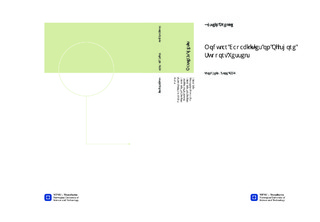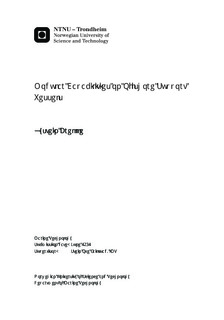| dc.contributor.advisor | Erikstad, Stein Ove | nb_NO |
| dc.contributor.author | Brekke, Øystein | nb_NO |
| dc.date.accessioned | 2014-12-19T12:07:28Z | |
| dc.date.available | 2014-12-19T12:07:28Z | |
| dc.date.created | 2012-11-08 | nb_NO |
| dc.date.issued | 2012 | nb_NO |
| dc.identifier | 566085 | nb_NO |
| dc.identifier | ntnudaim:7630 | nb_NO |
| dc.identifier.uri | http://hdl.handle.net/11250/238186 | |
| dc.description.abstract | The report is divided into three different categories; background, concept evaluation and comparison and the methodology development. The background gives a short introduction of product architecture, modularity and modularization and also a brief description of existing design concepts which are capable of offering modular capabilities in the operation phase of a vessels life cycle.The second part of the report is a review of possible advantages and disadvantages with the implementation of a similar concept as presented in the background on offshore support vessels. The review deals with several aspects such as increased flexibility, higher spot utilization and also how this concept can have effects in an environmental perspective. Direct challenges with modular capabilities such as equipment complexity, port logistics issues etc. has also been discussed. Finally the concept is evaluated from an economical perspective, discussing costs in short and long term perspectives and how to predict the costs of a conversion between operations.The result of the evaluation is that the concept has aspects that are presumed quite beneficial for ship owners. Noticeable are increased flexibility in the range of operations a vessel can perform, possibilities for a fleet reduction due to modular capabilities and also possibilities for economic benefits in forms of higher spot utilization and easier maintenance of equipment modules. It is also anticipated that the concept will make the vessel more receptive for new technology and equipment modules. The most repressive aspect regarding modular capabilities is by far each equipment modules high degree of complexity together with the low degree of independency.The concept has also been compared with multi-purpose OSV s and conventional mission specific OSV s within several different aspects considered important for ship owners. The results are generally favoring a vessel with modular capabilities, but also that the negative aspects of the concept might not be taken sufficient account for in the comparison.In the third and last part it is developed a methodology to establish the equipment structure of an offshore support vessel with modular capabilities. It establishes the function hierarchy of the vessel and defines the interactions between the equipment modules and the functions before each module is evaluated in light of modular complexity and vessel influence. Based on this the equipment structure is established and exchange intervals for the modules are proposed.To illustrate the steps of the methodology better a case study is performed based on 5 different operations; anchor handling, towing, pipe lay, construction and support. The case study gives two main indications:1. There are a potential in further development of the methodology. Mainly involving the modules interactions and the specific equipment evaluation.2. The equipment modules are as determined before very complex and require long exchange intervals and also extensive external support to swap modules. | nb_NO |
| dc.language | eng | nb_NO |
| dc.publisher | Institutt for marin teknikk | nb_NO |
| dc.subject | ntnudaim:7630 | no_NO |
| dc.subject | MTMART Marin teknikk | no_NO |
| dc.subject | Marin prosjektering og logistikk | no_NO |
| dc.title | Modular Capabilities on Offshore Support Vessels | nb_NO |
| dc.type | Master thesis | nb_NO |
| dc.source.pagenumber | 88 | nb_NO |
| dc.contributor.department | Norges teknisk-naturvitenskapelige universitet, Fakultet for ingeniørvitenskap og teknologi, Institutt for marin teknikk | nb_NO |

